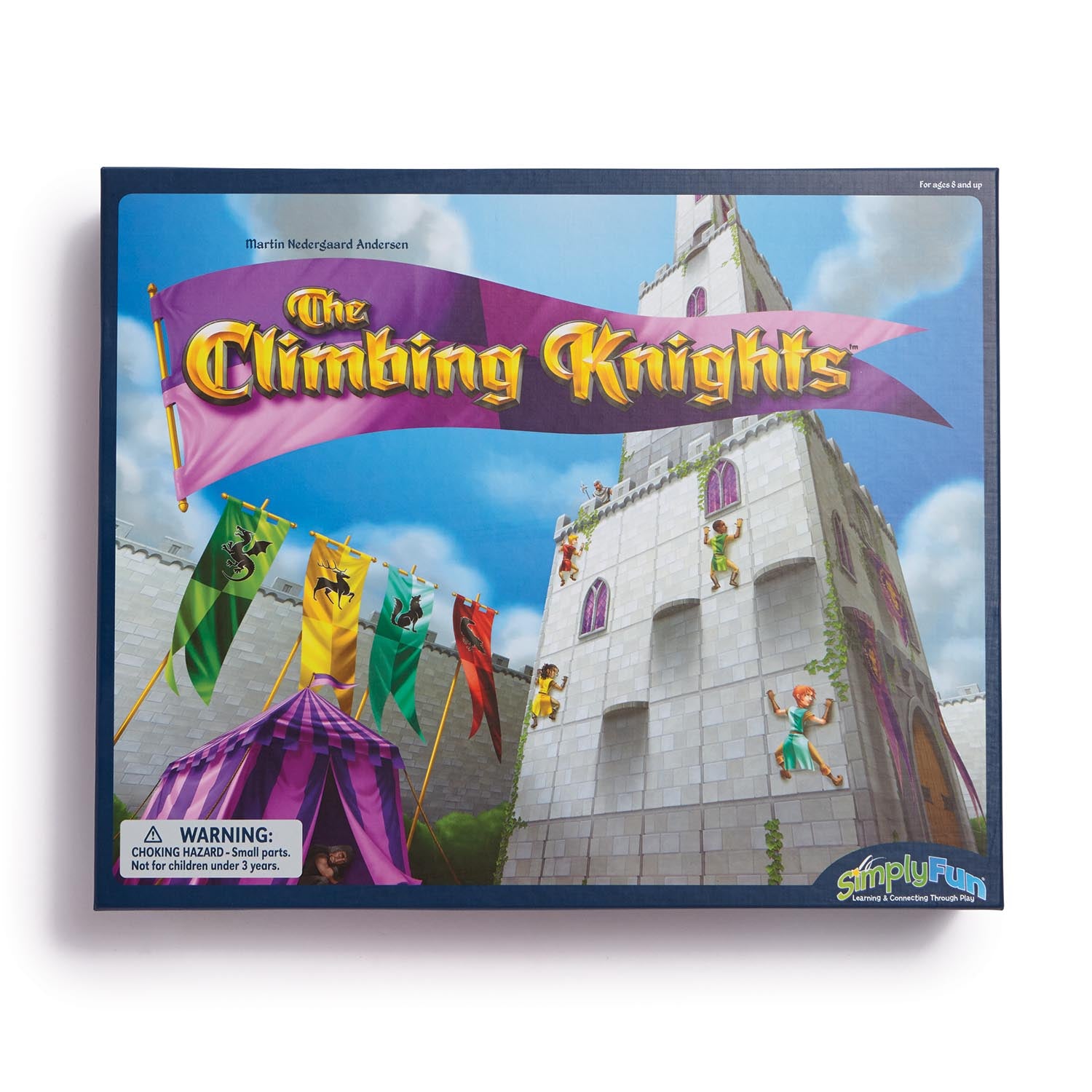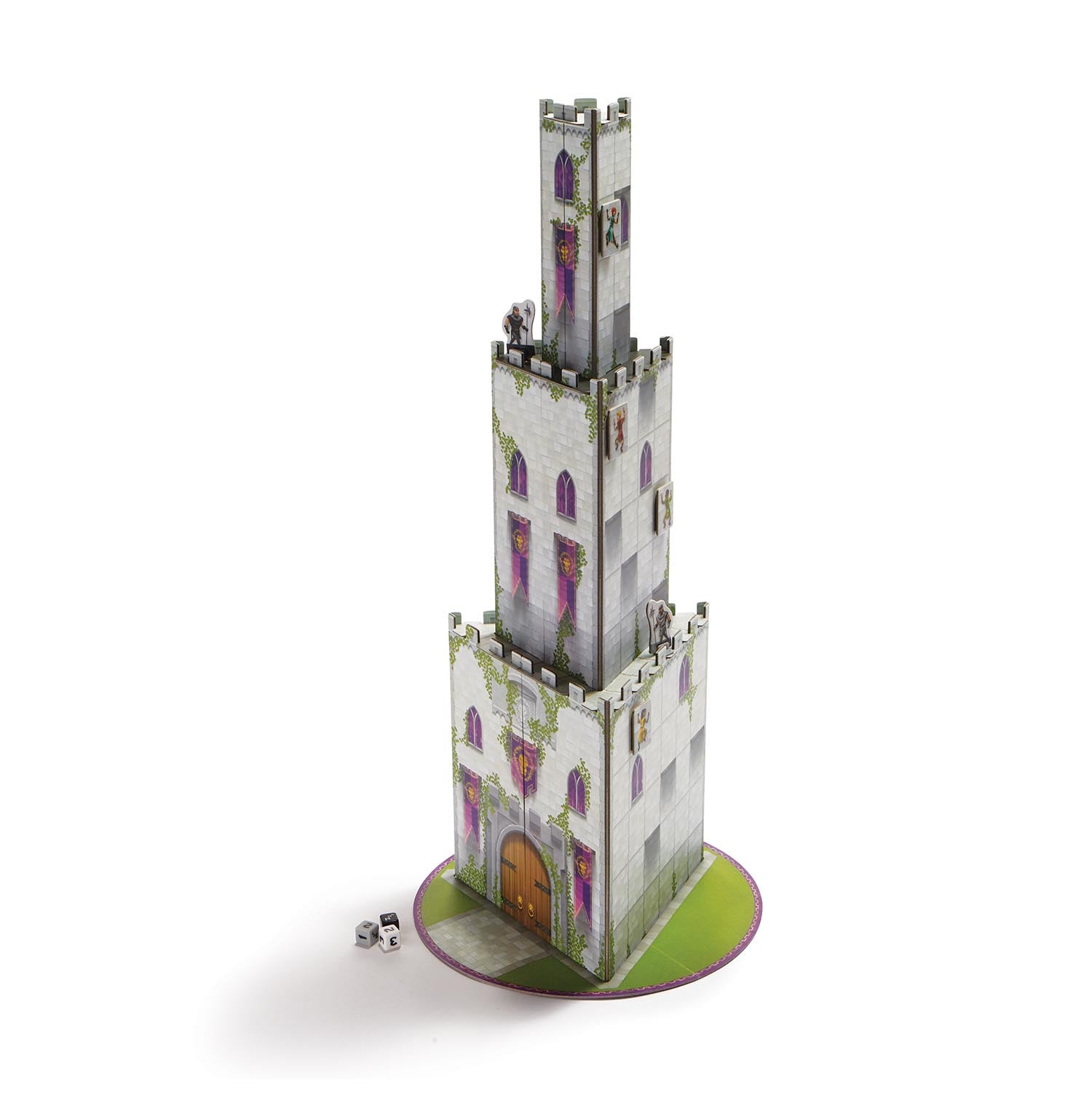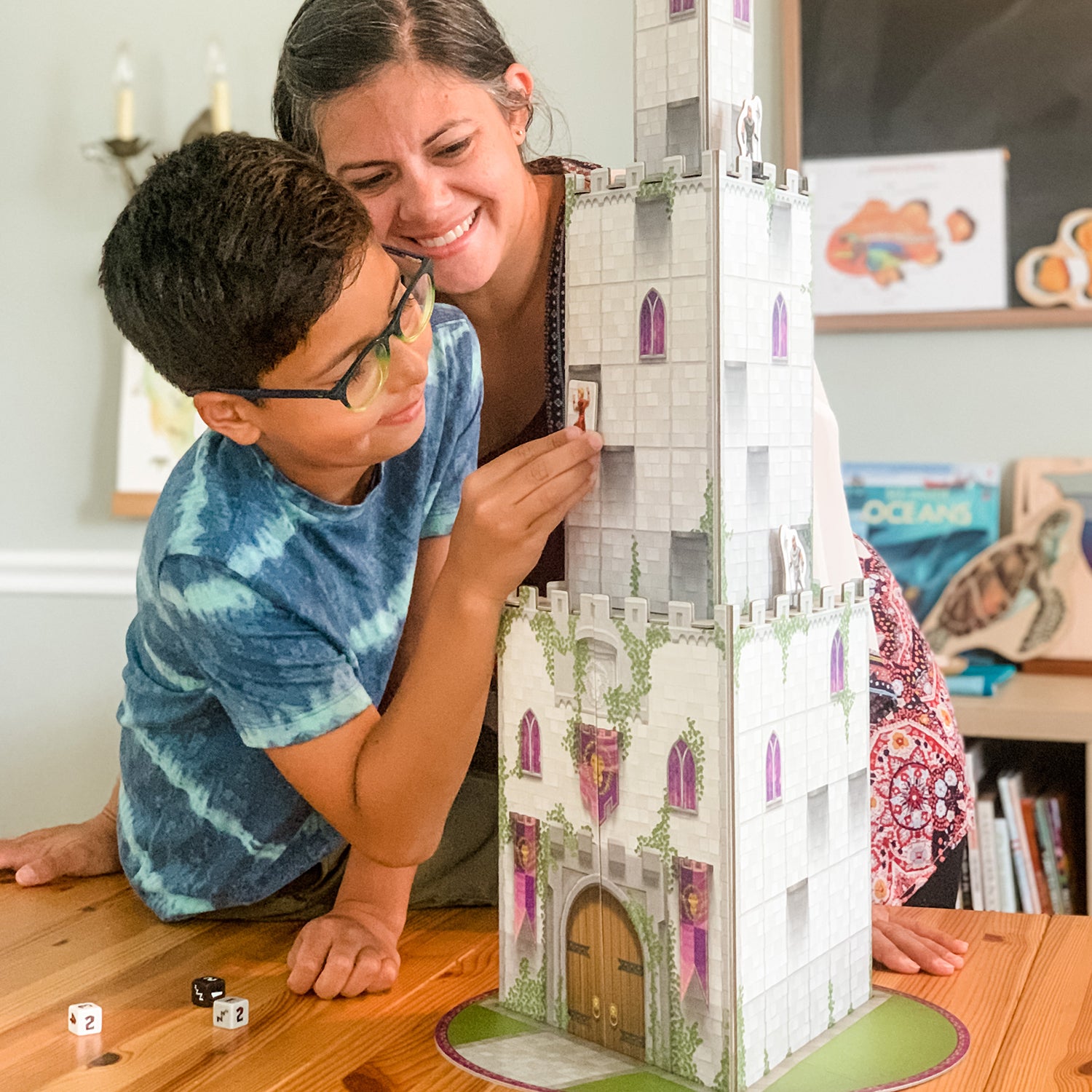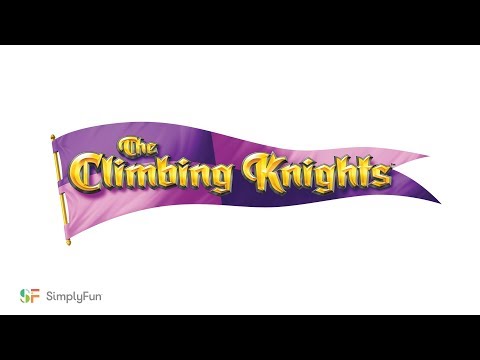The Climbing Knights
The Climbing Knights
2-4 players • 30 min • 8 & up
Focus: Fine Motor
Couldn't load pickup availability
Gear up and race to the top of the castle while dodging watchful guards! Use strategy to outsmart your opponents and boost your spatial reasoning and fine motor skills. Be the first to reach the top twice and claim your coat of arms to become the ultimate climber!
Skills: Spatial Reasoning, Strategy, Fine Motor Skills
Game Includes
Game Includes
- 1 Castle (Requires assembly)
- 4 Magnetic Knights (Each contains a flat magnet)
- 2 Guard Pawns
- 8 Coats of Arms
- 3 Dice
- 1 Rules Booklet
Share
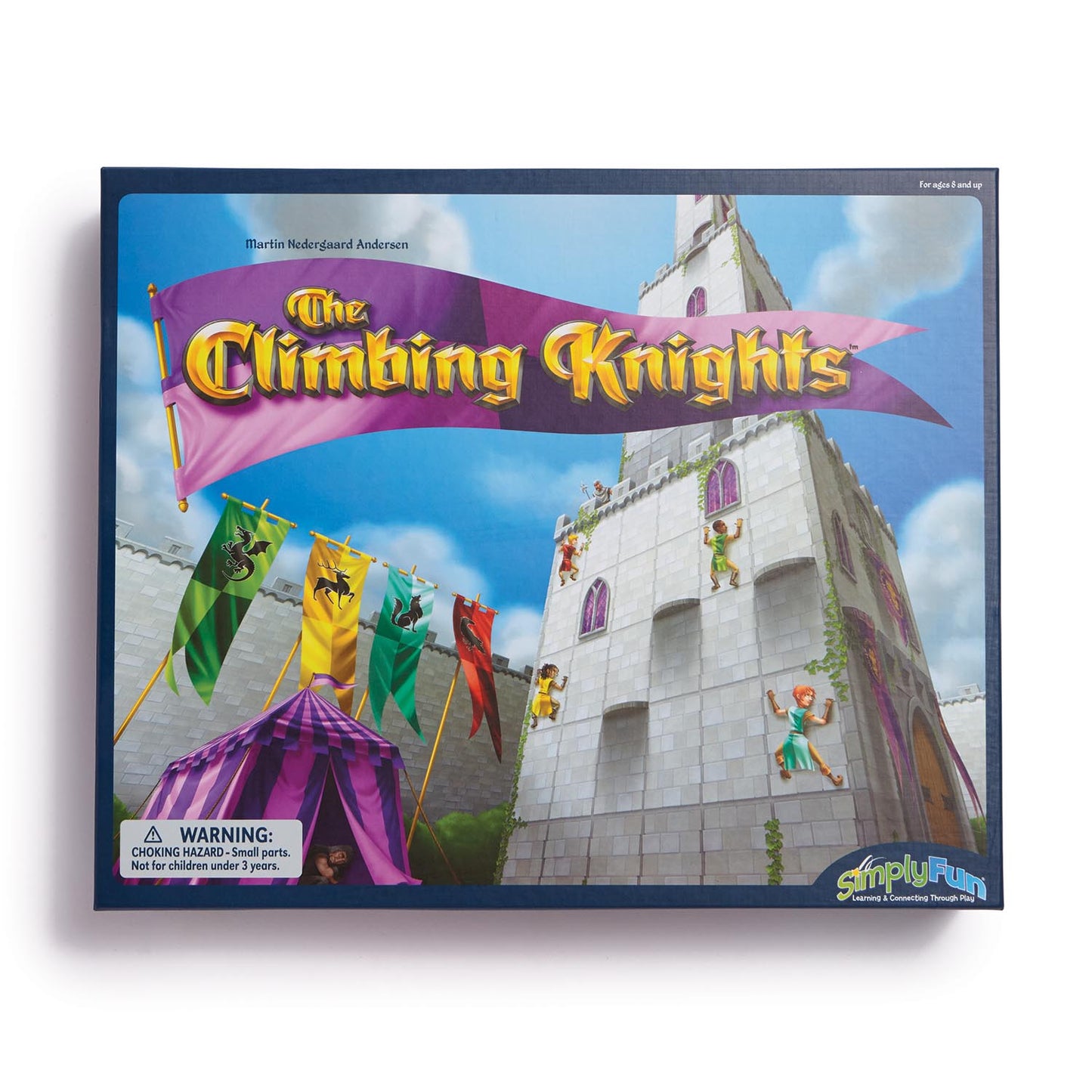
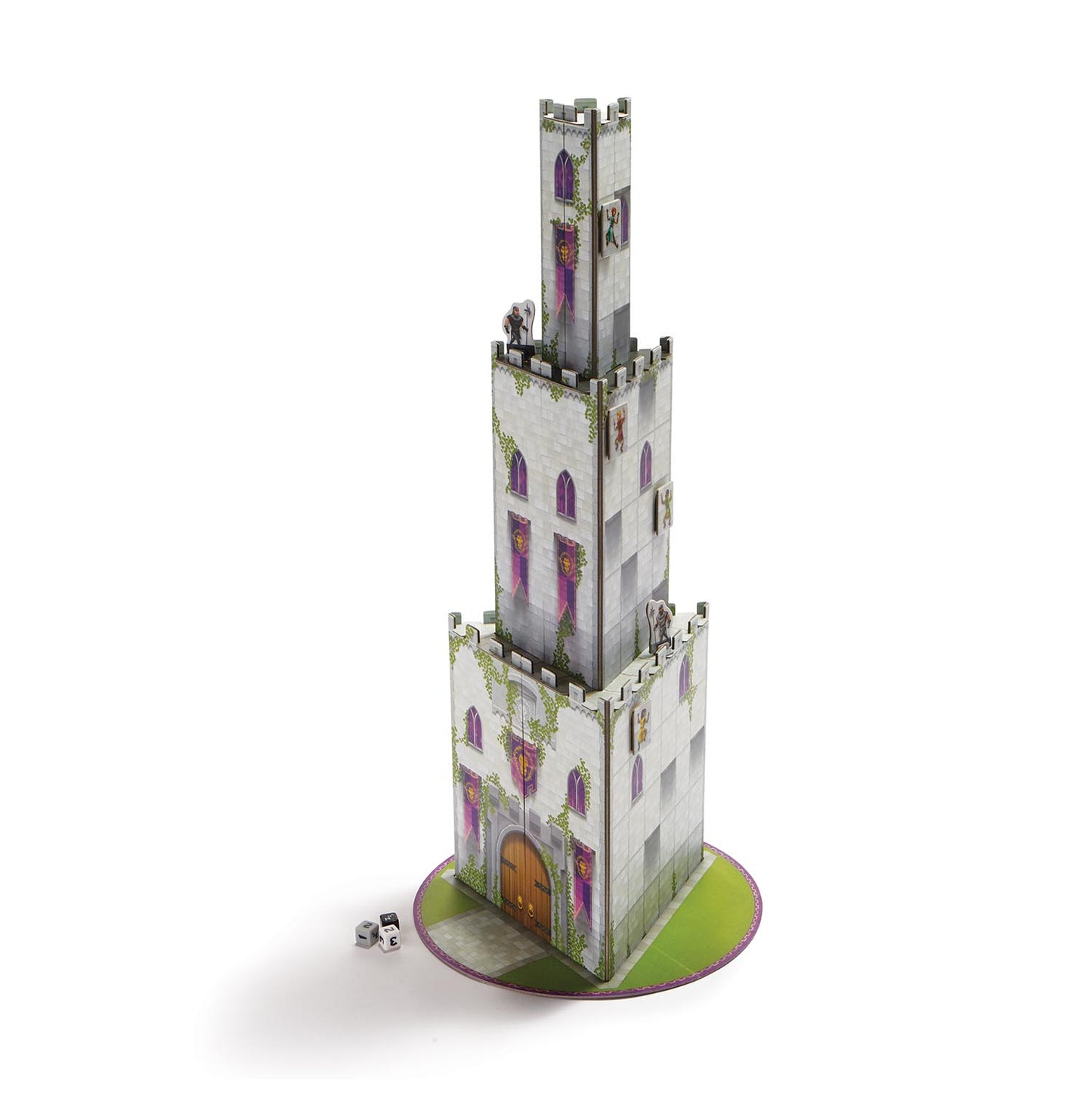
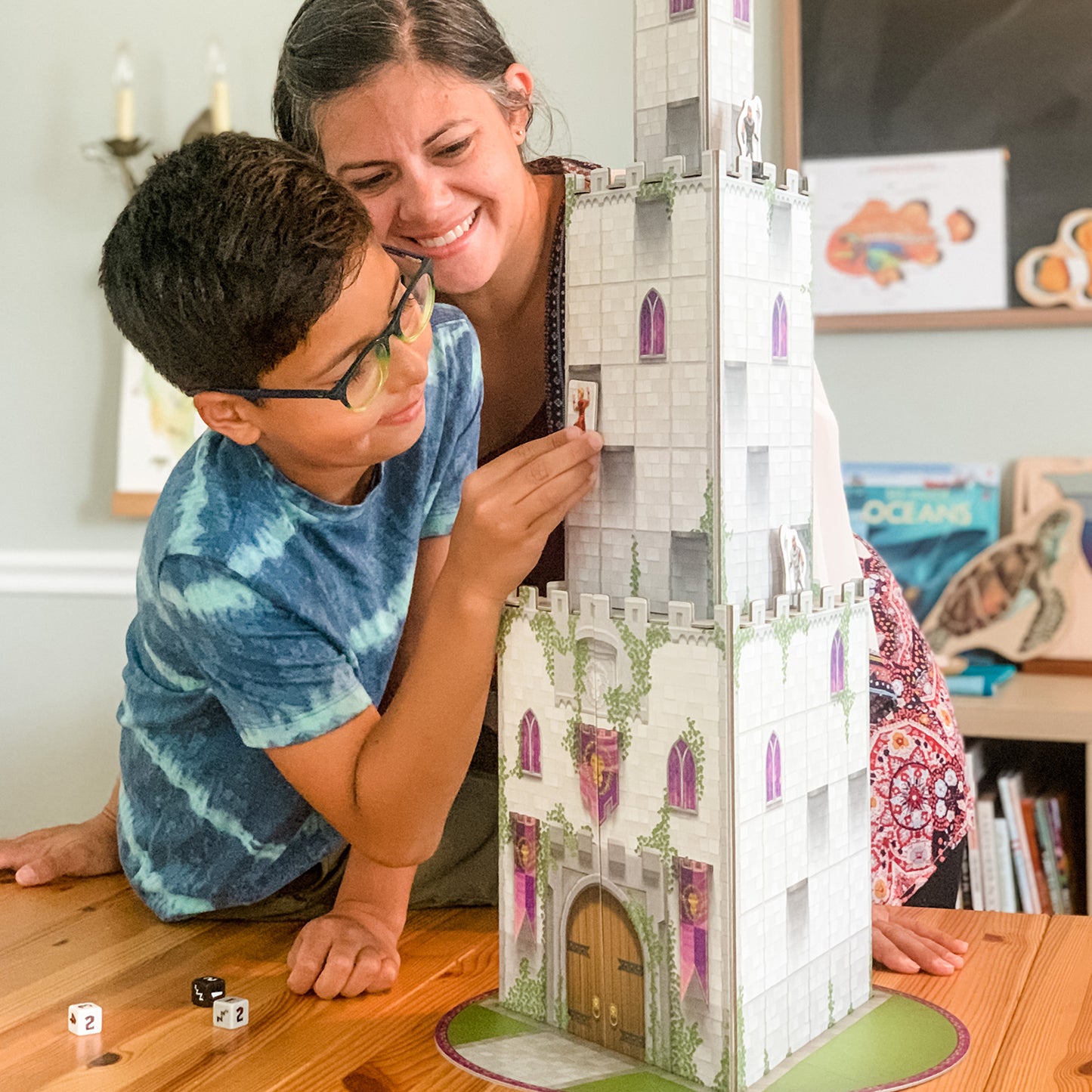

Collapsible content
How to Play
Educational Standards
Core Standard*: Math
- Math
- Generate and analyze patterns: Grade Level 4th
- Analyze patterns and relationships: Grade Level 5th
- Operations and Algebric Thinking
Skills
Explore
What Does Child Do To Use Skill In The Game?
Players explore the castle in Climbing Knights by looking around walls for safe paths to move their Knights.
How Parents Can Assist Learning
There are many factors that will effect where a child moves their Knight. Remind children to think about ledges, where the Guards are moving, and where other players are located to help them explore more carefully.
Learning Implications and Educator Support
Playing Climbing Knights helps children develop spatial reasoning skills, as well as planning and prediction as they map out a safe path to the top of the castle. There are many factors that will effect where a child moves their Knight. Remind children to think about ledges, where the Guards are moving, and where other players are located to help them explore more carefully.
Determine
What Does Child Do To Use Skill In The Game?
Players determine where to move in relationship to the location and likely movements of Guards and other players.
How Parents Can Assist Learning
To help children develop more thoughtful decision-making, parents can ask them to justify before they make a decision. Ask questions like, "How will moving your Knight there help you reach your goal?"
Learning Implications and Educator Support
Climbing Knights helps children develop thoughtful decision-making. Ask children to justify choices before they make a decision. Ask questions like, "How will moving your Knight there help you reach your goal?"
Compare
What Does Child Do To Use Skill In The Game?
Players will compare different options for moving their Knights and the paths they are trying to make up the castle. They will also compare the location of other Knights and the Guards.
How Parents Can Assist Learning
In order help children to reduce impulsivity, parents can encourage children to talk about different possible results based on varying choices for moving their Knight.
Learning Implications and Educator Support
Educators can assist in developing spatial reasoning by encouraging children to talk about different moves for their Knight to travel, including moving down, not moving or moving fewer than the number on the die, prior to deciding which to play. This will also help reduce impulsivity.
Predict
What Does Child Do To Use Skill In The Game?
Climbing Knights involves a some prediction as players try to determine the probability of Guards moving or sleeping.
How Parents Can Assist Learning
Parents can remind children that Guards can only move up to 2 spots in a turn and that they cannot look backwards. Additionally, ask children to think about where the other Knights are located and might be trying to move.
Learning Implications and Educator Support
Children can increase their ability to predict if they concentrate, compare options and look at the Guards and other Knights, rather than choosing a move impulsively. Help children by asking them to "Wait. Look. Think." Using such cues can give children a model for future play.
Plan
What Does Child Do To Use Skill In The Game?
Planning is a major element of Climbing Knights as players try to create a path to the top of the castle without getting seen by a Guard.
How Parents Can Assist Learning
To be successful in this game requires thinking about consequences beyond a player's immediate move. This type of long-term, sequential thinking is important beyond the game for activities such as building forts, making art, successfully completing schoolwork on time and launching a new business from a lemonade stand to a company later on in life.
Learning Implications and Educator Support
Planning is an important skill for developing strategic thinking, persistence and reaching a goal. Encourage the children to discuss the goal for the game and how they might play their pieces to reach the goal. Additionally, to be successful in this game requires thinking about consequences beyond a player's immediate move. This type of long-term, sequential thinking is important beyond the game for activities such as building forts, making art, successfully completing schoolwork on time and launching a new business from a lemonade stand to a company later on in life.
Experiment
What Does Child Do To Use Skill In The Game?
Climbing Knights allows players to try out different strategies that are more defensive or offensive.
How Parents Can Assist Learning
Climbing Knights is good for experimenting with strategy and tactics. Discuss different strategies such as defensive (which involves more hiding) or offensive (which involves trying to race up the castle) prior to starting the game and encourage the child to select one. Play the game and discuss. Then, play again with the child trying a different strategy. Discuss again and compare the advantages and disadvantages
Learning Implications and Educator Support
Climbing Knights is good for experimenting with strategy and tactics. Discuss different strategies such as defensive (which involves more hiding) or offensive (which involves trying to race up the castle) prior to starting the game and encourage the child to select one. Play the game and discuss. Then, play again with the child trying a different strategy. Discuss again and compare the advantages and disadvantages.
Solve
What Does Child Do To Use Skill In The Game?
Players attempt to solve and win the game by adapting to the moves of Guards and other Knights in order to retrieve their Coat of Arms first.
How Parents Can Assist Learning
Parents can talk to children about alternative approaches and help them think about choices. It is important for parents to not create the approaches, but help the children come to their own conclusions. Parents can encourage both offensive and defensive game strategy.
Learning Implications and Educator Support
Educators can talk to children about alternative approaches and help them think about choices. It is important for adults to not create the approaches, but help the children come to their own conclusions. Adults can encourage both offensive and defensive game strategy.
*Data compiled from CCSSI ELA Standards, WA Science Standards, and Washington Social Studies Standards
Special Needs
Cognitive
Suggestions for How to Modify Play Experience
Children with cognitive delays may have difficulty understanding the abstract concepts related to the Guards line of sight the ability of the Guards to "see" or "not see" the Knights. The climbing magnets, however, will be lots of fun to move. Simplify the rules so that their is only one Guard and the Guard can see anyone on the side he is standing. This will enable the players to move to a non-visible side. Remind the child to watch the Guard and anticipate where he is moving, so they can plan their moves.
Keep the same rules, but play in teams. This way, the child has a coach to help them think about each move and the position of the Guards.
Communication
Suggestions for How to Modify Play Experience
Players do not need to communicate to play the game, but children can be encouraged to talk about their moves and what their Knight is thinking about.
If the child has difficulty comprehending language, demonstrate each step of the directions. Use gestures and physical movements (ex: pretend to look over a ledge and down) to show the actions of the Knights. Visual dramatization helps children pair words and actions with meaning.
Sensorimotor
Suggestions for How to Modify Play Experience
Although players need to move their Knight, the pieces slide easily on the wall. Moving the Guards requires more fine motor skill, but players can assist each other, making the game more cooperative.
Social Emotional/Behavioral
Suggestions for How to Modify Play Experience
If a Knight is seen by a Guard, the player falls to the bottom of the level below. This may be frustrating for children who don't tolerate setbacks well. To make this aspect of the game a little easier to handle, change the rules so that if the Knight is seen, he just falls 3 spaces. Build up tolerance by adding a space to the fall after several rounds.
Play in pairs to build cooperation skills.
Vision
Suggestions for How to Modify Play Experience
As is, Climbing Knights is not recommended for children with low vision, as the pattern for movement is not high contrast and is thus hard for these children to see.
The game could be modified by using bright markers of different colors to color in the squares and mark "ledges" so children with low vision can see their options.
Hearing
Suggestions for How to Modify Play Experience
Climbing Knights can be played without talking, but players will need to read or use visual skills to learn the directions.
Part of the fun of the game is communicating during the game, encourage players to use sign and gestures to communicate.
*Data compiled from CCSSI ELA Standards, WA Science Standards, and Washington Social Studies Standards
Autism
Autism Strengths & Interests
Short Summary of Strengths & Interests
- Has good spatial reasoning skills.
- Can concentrate on more than one aspect of play at a time.
- Has good logic and decision-making skills.
Is good at matching visual items
Has a good memory for sensory details, including visual, touch, taste and smell
Has a good memory for words, phrases and dialouge
This game is not appropriate
Has a good memory for pictures, numbers and patterns
This game is not appropriate
Likes to put things in order or a sequence
This game is not appropriate
Learns through visualizing or "replaying" actions in their mind
Is This Game Appropriate? Yes
Description
Players can learn by thinking about what worked or didn't work in previous plays.
Likes activities with rules, such as math and phonics
This game is not appropriate
Is very concrete and literal
Is This Game Appropriate? Yes
Description
Climbing Knights is a concrete game because players can see the movement of their knight and immediately experience the results of their actions.
Learns in small "chunks" (for example, phone numbers are 3 chunks of number xxx-xxx-xxxx that are combined together)
This game is not appropriate
Is good at nonverbal reasoning and logic
Is This Game Appropriate? Yes
Description
Players win the game by watching the placement and anticipating the potential movements of the Guards and other Knights and planning their movements accordingly. Players need to think offensively and defensively with each play.
Likes spatial problem solving
Is This Game Appropriate? Yes
Description
Climbing Knights is a great spatial problem solving game as players need to figure out how to climb the castle while avoiding the Guards who are moving around the platforms.
Can read well with good vocabulary, though may not fully comprehend content
This game is not appropriate
Likes to use and has good fine motor skill
Is This Game Appropriate? Yes
Description
Some fine motor skills are needed to move the pieces, but the Knights move with a one finger slide. If needed, other players can maneuver the Guards on their walkway.
Likes established routines or set ways of doing things
This game is not appropriate
Likes manipulating, constructing or building things
Is This Game Appropriate? Yes
Description
Building the castle is a fun part of the game and also requires visual spatial reasoning and fine motor skills that children who like building toys or activities will enjoy.
Likes to use and has good musical abilities
This game is not appropriate
Likes to use and has good drawing skills
This game is not appropriate
Autism Special Considerations
Appears to ignore other's communication and/or has difficulty giving eye contact to a communication partner
Is This Game Appropriate for Child with Characteristic? Yes
Can Child with Characteristic Play Game w/o Modification? Yes
Strategies for Developing Compensatory Skills:
Climbing Knights can be played by attending to the game rather than other players. This makes it more motivating for children with autism.
Has difficulty understanding complex verbal directions
Is This Game Appropriate for Child with Characteristic? Yes
Can Child with Characteristic Play Game w/o Modification? No
Strategies for Developing Compensatory Skills:
The directions for playing Climbing Knights are rather abstract, but the use of gestures and demonstration of play should clarify the rules for children with autism. Walk the child through the first round of play as partners, so he has visual and verbal guidelines.
Uses vocabulary inaccurately or demonstrates echolalia (repeating another's speech)
Is This Game Appropriate for Child with Characteristic? Yes
Can Child with Characteristic Play Game w/o Modification? Yes
Strategies for Developing Compensatory Skills:
As long as the other players can concentrate on the game, the child echolalia of the child with autism should not interfere with their play. Try to redirect their comments to the game and actions of the Knights and Guards.
Gets stuck repeating a verbal topic or physical actions and/or has difficulty attending to others' actions or topic.
Is This Game Appropriate for Child with Characteristic? Yes
Can Child with Characteristic Play Game w/o Modification? No
Strategies for Developing Compensatory Skills:
Players can concentrate on their own moves, but it is also important to watch where the Guards are and where other players' Knights are located. If the child's repetitive behaviors interfere with attention to the game, the game may be to difficult.
Has difficulty producing speech/communication
Is This Game Appropriate for Child with Characteristic? Yes
Can Child with Characteristic Play Game w/o Modification? Yes
Strategies for Developing Compensatory Skills:
Communication is not needed during the game, but children can be encouraged to discuss the game play.
Has difficulty sequencing multi-step actions and/or doing complex abstract tasks
Is This Game Appropriate for Child with Characteristic? Yes
Can Child with Characteristic Play Game w/o Modification? No
Strategies for Developing Compensatory Skills:
The child makes three steps in every turn, one to move the black Guard, one to move the gray Guard, and one to move his Knight. These are easy to follow as one throw of the dice reveals what needs to be done for each. If this sequence is too difficult, the child can partner with another player until they can do the actions independently.
Demonstrates difficulty initiating and maintaining social interactions
Is This Game Appropriate for Child with Characteristic? Yes
Can Child with Characteristic Play Game w/o Modification? Yes
Strategies for Developing Compensatory Skills:
Social interaction is not needed to play Climbing Knights, but it can be encouraged through questioning and commenting.
Acts out or demonstrates avoidance behaviors when frustrated, overwhelmed, or needs more sensory input.
Is This Game Appropriate for Child with Characteristic? Yes
Can Child with Characteristic Play Game w/o Modification? No
Strategies for Developing Compensatory Skills:
Give the child breaks for movement in between turns. Make sure the child scans where all Guards and Knights are located when returning to the game. Remind the child of the goal of his turn and the steps to take next.
Has short attention span for non-preferred activities
Is This Game Appropriate for Child with Characteristic? Yes
Can Child with Characteristic Play Game w/o Modification? No
Strategies for Developing Compensatory Skills:
If spatial problem solving is a preferred activity, the child with autism may like this game, especially the three-dimensional aspect and the magnetic Knights.
Needs sameness or consistent routines and/or has difficulty with transitions from one activity to another
Is This Game Appropriate for Child with Characteristic? Yes
Can Child with Characteristic Play Game w/o Modification? No
Strategies for Developing Compensatory Skills:
Transition the child with autism to the game by encouraging him to help you construct the tower. Construction puzzles are often fun for them to do. Once complete, they will be ready to play with the Knights and Guards!
Has difficulty understanding others' feelings, intentions, and the reasons for others' actions.
Is This Game Appropriate for Child with Characteristic? Yes
Can Child with Characteristic Play Game w/o Modification? No
Strategies for Developing Compensatory Skills:
Children can play without understanding other players' feelings. However, emphasize how other players look and feel when their Knight falls or they reach the top of the tower. Discuss feelings, such as frustration, relief, excitement, and so on.
*Data compiled from CCSSI ELA Standards, WA Science Standards, and Washington Social Studies Standards
Extended Play
Extra Ways to Play the Game
With current rules Knights cannot land on windows. Modify the rules so that Knights can land on a window, but if they do the player needs to tell a short story of what is happening inside the castle when the Knight looks in the window.
Materials Needed
No additional materials needed.
Developmental Benefits
Being able to land on a window is an advantage for the Knight's movement. To gain this advantage, however, players need to add an imaginative element by telling a brief story of what is happening inside the castle. This adds a narrative element which builds communication and story telling skills.
Extra Ways to Play the Game
Use the castle, Guards and Knights for dramatic play. Encourage children to make up stories involving the characters. Add other toys to increase imaginative ideas.
Materials Needed
No materials are needed, but adding additional toys and props will expand the dramatic play options.
Developmental Benefits
Dramatic play allows children to play different characters, make up stories, and insert dialogue. This helps develop creative thinking, narrative skills, social interaction, communication, and problem solving.
*Data compiled from CCSSI ELA Standards, WA Science Standards, and Washington Social Studies Standards
Collapsible content
How to Play Video & Transcript
Today, you’ll bolster your strategy and spatial reasoning skills as you scale the castle wall to retrieve your Coats of Arms and win the title of King’s Climber in Simply Fun’s The Climbing Knights.
The Climbing Knights can be played with 2 to 4 players and is best for players ages 8 and up.
In each Climbing Knights game box you’ll find:
1 castle that requires some assembly… and 8 Coats of Arms in four colors. The Coats of Arms are placed at the top of the Castle for the Knights to retrieve.
There are 4 magnetic Knights that will scale the walls of the castle…
..but there are also 2 Guard Pawns, one Black and one Gray, who will try to keep the Knights from getting to the top. Watch out for them!
Finally, there are 3 dice: one Black, one Gray and one White, that indicate the number of spaces different pieces will move – or not move, as the case may be.
To assemble the castle, follow the instructions in the booklet provided in the game box. Then set up the rest of the game.
There are three sides to the castle, two are climbing walls and the front with the door that is only for sliding down, not for climbing.
Place the Black Guard on the starting space on the upper level walkway of the Castle and the Gray Guard on the starting space on the lower level walkway. Both guards should have their “awake” side facing out and be pointed in the direction of the arrow. They’ll be going in opposite directions.
Give each player one Knight and two matching Coats of Arms. All players stack their Coats of Arms together at the top of the Castle. Then, each player places his Knight anywhere on the first row of either of the climbing walls.
The goal of the game is to be the first player to climb the tower twice to retrieve both of their coat of arms.
Place the three dice where everyone can reach them.
To start the game, the first player will roll all three dice at the same time and follow 3 steps in order:
Step 1: Follow the action on the black die to move the Black Guard.
• If the black die shows Zzz, the Black Guard immediately falls asleep and nothing happens.
• If the black die shows a number, move the Black Guard that number of spaces. After the Guard is moved check to see if he sees a Knight. Guards can see Knights that are straight up, straight down or straight ahead of them. They cannot see behind them or around corners or behind ledges.
• If he sees a Knight, the Knight immediately falls straight down to the first row of the level below. If the Knight happens to fall to a space occupied by another Knight, it must go to the nearest open space to the left or the right. If the Knight falls and is seen by the Gray Guard the knight must fall to the ground level and be placed anywhere on the first row of either climbing wall.
Step 2: Now follow the action on the gray die to move the Grey Guard, repeating the same steps as the Black G uard. If Knights are seen, they fall down to the ground level and start their climb again.
Step 3: Move your Knight equal to or less than the number on the white die, being careful to avoid the Guards’ line of sight.
• You can move your Knight vertically or horizontally on either side of the climbing walls. You may move around the corner from one wall to the other as long as you stay on the climbing walls. You may hide behind and move over ledges. If your Knight is behind a ledge the Guards cannot see you. Knights may move over ledges, just like any other space on the wall.
• Knights may not move diagonally or on to the front of the castle. Knights may never move on or over windows or on or over other Knights.
• You may even choose to not to move your Knight at all, especially if there is no place to hide from a guard.
The instruction booklet will guide you on the specific rules about moving the Guards, moving the Knights, avoiding the Guards and when and how the Guards can see the Knights.
Play continues clockwise as players take turns rolling the dice, moving guards and climbing the Castle. Note that the guards only stay asleep until another player moves them.
Once a Knight reaches the top of the Castle, he claims his Coat of Arms. He must wait until his next turn, though – or until it’s safe – to slide down and start the climb again for his second Coat of Arms.
To slide down, roll the dice and move the Black and Gray guards as usual. If a guard is walking on either level on the front side of the Castle, the Knight cannot slide down. If there’s no guard on either level, the Knight may slide all the way down on any number of the white die. Once down, he may begin the climb for the second Coat of Arms.
The games ends when the first Knight retrieves both Coats of Arms.
Earn the prestigious title of King’s Climber and protect Castle’s tallest spire in Simply Fun’s The Climbing Knights.
Subscribe for More Fun!
Be the first to know about new games, exclusive offers and more.
- YouTube
- TikTok
- X (Twitter)
- Choosing a selection results in a full page refresh.
- Opens in a new window.



